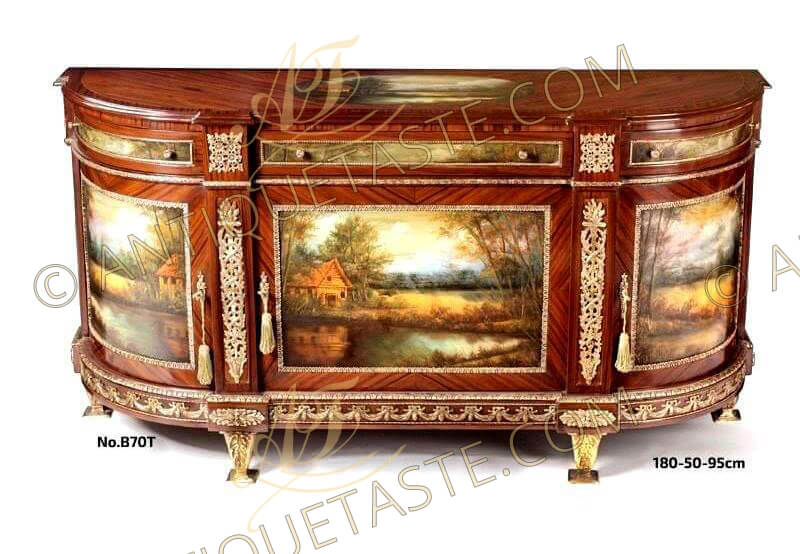Ref#B70T | Description
Antique Taste masterpiece reproduction of the spectacular French Louis XVI sans traverse veneer inlaid sideboard on the manner of François Linke, after the model of the commode in the Chamber of King Louis XVI by Joseph Stöckel and Guillaume Benneman mid-19th century,
We changed the ormolu mounted model to the Vernis Martin style. The cabinet is raised by opulent tapering gilt-ormolu acanthus supports surmounted with rosettes ormolu mounted built-in blocks to the frieze. The 'D' shaped frieze is elegantly decorated by ormolu fitted floral swaging wreath garlands and hammered ormolu filet.
The three doors and three drawers are hand painted on the Vernis Martin style with outdoor scenes and framed with ormolu bead-and-dart bands. The cabinet in the central part is divided with two breakfronts ornamented with pierced ormolu designs of foliage, eternal flame and pierced foliate rosettes to the top.
The demilune break-fronted top is palisander sans traverse veneer inlaid and painted with an oval outdoor scene. Exceptional quality throughout.
----
The appearance of this original furniture was initially very different. It was part of a series of four convenient monumental, purchased by the Garde-Meuble at the Marchand-Mercier, Philippe-Ambroise Wild in 1786. These dressers had seems to you it was executed by the cabinetmaker Joseph Stockel to the attention of the Count of Provence.
The four furniture were altered by Benneman for the Garde-Meuble. Benneman decreased a little bit its length as a function of the location it would have occupied originally plated rose wood, it has replaqua mahogany and replaced the sash central by three drawers current. The bronzes were gilded by Pierre - François Feuchère.
The commode left the house of the King at Compiègne under the Revolution, but never ceased to be appreciated. It was sent in 1797, the Palace of Directors of the Luxembourg, and was then used in the Tuileries Palace until 1870. It is found in 1807, in the third living room of the apartment of the Emperor. Restored in 1809 by Jacob-Desmalter, she appeared in the large bedroom of Napoleon, and remained there when it was occupied by Louis XVIII and was used in the Restoration. It was copied at the end of the Nineteenth century, notably by the cabinetmaker Henry Dasson.
Ref#B70T
180 x 50 x 95cm
Guillaume Benneman
Guillaume Benneman arrived in Paris from Germany in the early 1780s as an unknown ébéniste but was soon chosen to provide furniture for the royal family. At first he simply repaired the royal family's existing furniture and made functional objects such as firescreens, boxes, and bidets. Benneman then became the court ébéniste, copying and altering existing furniture to unify the interiors of the royal residences.
As his work gained the Crown's admiration, large sums of money passed from the royal coffers to Benneman to outfit his workshop with tools and equipment for sixteen craftsmen. Under the direction of the sculptor Jean Hauré, who acted as coordinator, Benneman produced pieces in the style of such ébénistesas Jean-Henri Riesener and Jean-François Oeben. He also altered existing pieces of furniture by removing porcelain plaques and mounts from one piece and placing them on a new copy. The old piece then served as a base for a new design.
Benneman continued to work throughout the French Revolution, although at a reduced level, but during the Directoire he gained a certain amount of new business. Scholars have difficulty assessing this cabinetmaker's personal style as his best-known objects are copies of other eighteenth-century ébénistes.
Tags
- #Commode-of-Chamber-Louis XVI | #Joseph Stöckel-Commode | #Guillaume-Benneman-Cabinet | #François-Linke-Vernis-Martin-Chest | #French-Louis XVI-Sideboard | #Parquetry-and-Marquetry-Bahut | #French-Bahut | #Japanese-lacquer-and-ebony-Sideboard | #Japanese-Black-small-Buffet | #Jean-Henri-Riesener-Bahut | #Empire-Style-Cabinet | #Napoleon-Style-Sideboard | #Napoleon-Second-Empire-Furniture | #Francois-Linke-Display-Cabinet | #Leon-Message-ormolu-design | #Haentges-Frères-Commode | #French-style-Cartonnier | #French-style-Cupboard | #French-Bombe-Commode | #19th Century Transitional style Commode | #Jean-François Leleu Commode | #Napoleon III Commode | #Napoleon III style Cabinet | #Napoleon III Side Cabinet | #Napoleon III Sideboard | #Meuble A Hauteaur D'appui | #Commode a vantaux | #Antoine Gaudreaux Commode | #Jean-Henri Riesener commode | #Marie-Antoinette commode | #Charles Cressent commode | #Maison Millet commode | #Pierre Antoine Foullet commode | #André Charles Boulle commode | #French style commode | #Louis XV commode | #Louis XIV commode | #Louis XVI commode

